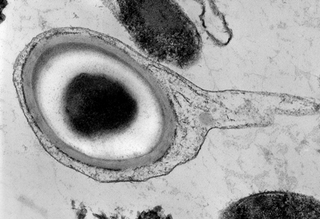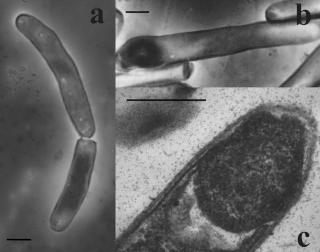Related Research Articles
The Thermomicrobia is a group of thermophilic green non-sulfur bacteria. Based on species Thermomicrobium roseum and Sphaerobacter thermophilus, this bacteria class has the following description:

Carboxydothermus hydrogenoformans is an extremely thermophilic anaerobic Gram-positive bacterium that has the interesting property of producing hydrogen as a waste product while feeding on carbon monoxide and water. It also forms endospores.
Thermus thermophilus is a Gram-negative bacterium used in a range of biotechnological applications, including as a model organism for genetic manipulation, structural genomics, and systems biology. The bacterium is extremely thermophilic, with an optimal growth temperature of about 65 °C (149 °F). Thermus thermophilus was originally isolated from a thermal vent within a hot spring in Izu, Japan by Tairo Oshima and Kazutomo Imahori. The organism has also been found to be important in the degradation of organic materials in the thermogenic phase of composting. T. thermophilus is classified into several strains, of which HB8 and HB27 are the most commonly used in laboratory environments. Genome analyses of these strains were independently completed in 2004.
Hydrogenobacter thermophilus is an extremely thermophilic, straight rod (bacillus) bacterium. TK-6 is the type strain for this species. It is a Gram negative, non-motile, obligate chemolithoautotroph. It belongs to one of the earliest branching order of Bacteria. H. thermophilus TK-6 lives in soil that contains hot water. It was one of the first hydrogen oxidizing bacteria described leading to the discovery, and subsequent examination of many unique proteins involved in its metabolism. Its discovery contradicted the idea that no obligate hydrogen oxidizing bacteria existed, leading to a new understanding of this physiological group. Additionally, H. thermophilus contains a fatty acid composition that had not been observed before.
Caldisericum exile is a species of bacteria sufficiently distinct from other bacteria to be placed in its own family, order, class and phylum. It is the first member of the thermophilic candidate phylum OP5 to be cultured and described.
Thermoanaerobacter is a genus in the phylum Bacillota (Bacteria). Members of this genus are thermophilic and anaerobic, several of them were previously described as Clostridium species and members of the now obsolete genera Acetogenium and Thermobacteroides
Caldicellulosiruptor saccharolyticus is a species of thermophilic, anaerobic cellulolytic bacterium. It was isolated from a piece of wood floating in the flow from a freshwater thermal spring in New Zealand in 1987, and tentatively named Caldocellum saccharolyticum. In 1994, the isolate was more thoroughly characterized physiologically, and classified to a new genus, Caldicellusiruptor, based on 16S RNA sequence. It is the type species, and more thoroughly studied member of its genus.
Muricauda ruestringensis is a bacterium. It is a facultatively anaerobic, appendaged bacterium first isolated from the North Sea. Its nearest relative is Zobellia uliginosa. The type strain is strain B1T.
Pelotomaculum thermopropionicum is an anaerobic, thermophilic, syntrophic propionate-oxidizing bacterium, the type species of its genus. The type strain is strain SI(T).
Methanomethylovorans thermophila is a species of thermophilic, methylotrophic methanogenic microbe. It is Gram-negative, and its type strain is L2FAWT. It was isolated from an anaerobic reactor in a laboratory. Its cells are Gram-negative, non-motile, and coccoid in form. It has been found to use methanol and methyl amines as substrates in the production of methane. It cannot use formiate, carbon dioxide with hydrogen, acetate, dimethyl sulfide, methanethiol, or propanol. As its name suggests, it is a thermophile, with an optimal growth temperature of 50 °C.
Clostridium stercorarium is a cellulolytic thermophilic bacterium. It is anaerobic, spore-forming and saccharoclastic, with cells being rod-shaped and 0.7 to 0.8 by 2.7 to 7.7 µm in size. Its genome has been sequenced.
Thermosyntropha lipolytica is a lipolytic, anaerobic, alkalitolerant, thermophilic bacteria. It lives in syntrophic coculture with a methanogen. Its cells are non-motile, non-spore forming, straight or slightly curved rods. Its type strain is JW/VS-265T.
Thermoanaerobacterium aotearoense is a slightly acidophilic, anaerobic, thermophile first isolated from hot springs in New Zealand, hence its name. It is Gram-negative, peritrichously flagellated, rod-shaped forming oval terminal endospores. Strain JW/SL-NZ613T is its type strain. Its genome has been sequenced.
Symbiobacterium thermophilum is a symbiotic thermophile that depends on co-culture with a Bacillus strain for growth. It is Gram-negative and tryptophanase-positive, with type strain T(T). It is the type species of its genus. Symbiobacterium is related to the Gram-positive Firmicutes and Actinobacteria, but belongs to a lineage that is distinct from both.S. thermophilum has a bacillus shaped cell structure with no flagella. This bacterium is located throughout the environment in soils and fertilizers.
Balnearium lithotrophicum is a species of bacterium described in 2003 and classified as belonging to the Aquificota.
Caminibacter profundus is a species of moderately thermophilic, microaerobic to anaerobic, chemolithoautotrophic bacterium. It is a Gram-negative, non-motile rod, with type strain CRT.
Deferribacter desulfuricans is a species of sulfur-, nitrate- and arsenate-reducing thermophile first isolated from a deep-sea hydrothermal vent. It is an anaerobic, heterotrophic thermophile with type strain SSM1T.

Carboxydocella is a Gram-positive and obligate anaerobe bacterial genus from the family of Syntrophomonadaceae.
Caldanaerobius zeae is a Gram-positive thermophilic, anaerobic, non-spore-forming bacterium from the genus of Caldanaerobius which has been isolated from organic waste leachate in Hoopeston in the United States.
Caloranaerobacter azorensis is a Gram-negative, thermophilic, anaerobic, chemoorganotrophic and motile bacterium from the genus of Caloranaerobacter which has been isolated from a deep-sea hydrothermal vent from the Lucky Strike hydrothermal vent site from the Mid-Atlantic Ridge.
References
- ↑ Sokolova, T. G. (2002). "Carboxydocella thermautotrophica gen. nov., sp. nov., a novel anaerobic, CO-utilizing thermophile from a Kamchatkan hot spring". International Journal of Systematic and Evolutionary Microbiology. 52 (6): 1961–1967. doi:10.1099/ijs.0.02173-0. ISSN 1466-5026.